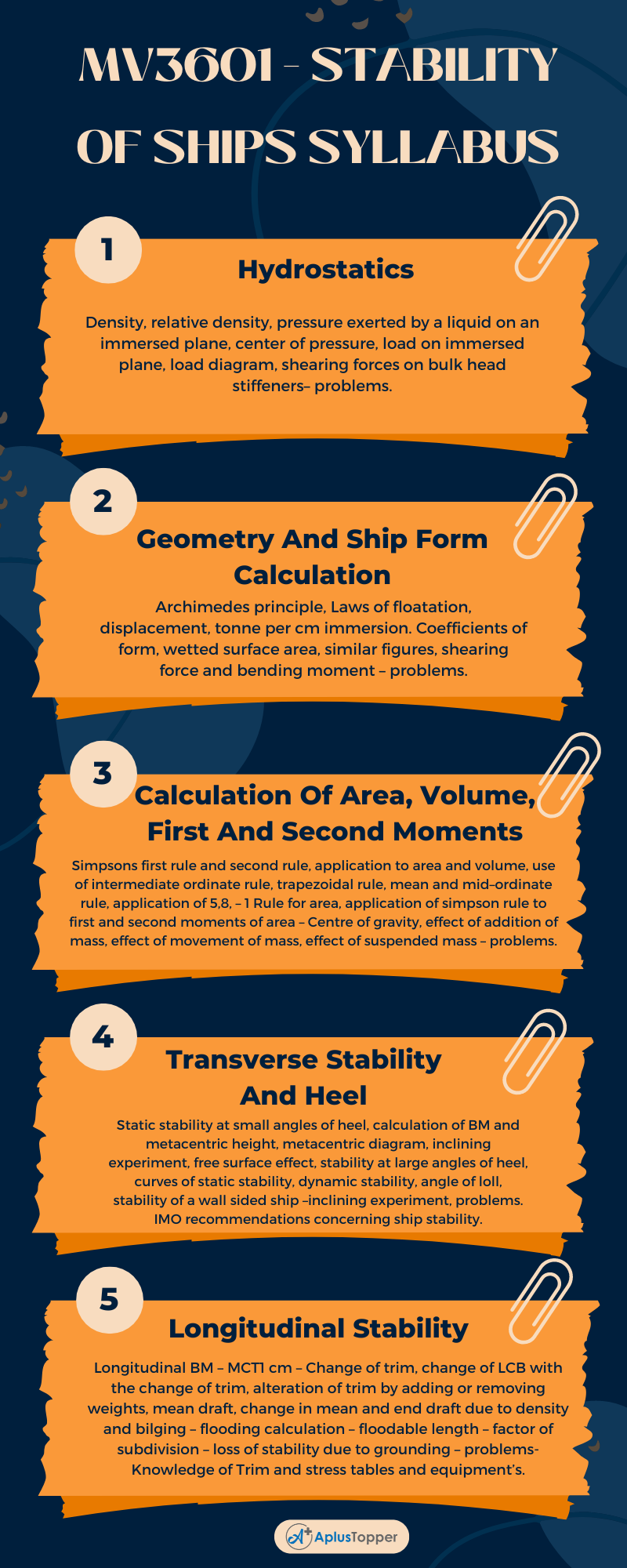Stability Of Ships is a dynamic subject that continuously shifts from one perspective to another. However, the technicality is the same even if the theories and perspectives vary. Hence to gain knowledge in this subject you must be equipped with more vicious on the syllabus.
In this article, we tried to provide the required syllabus of the MV3601 Stability Of Ships subject to gain command of the subject matter. By the end of the course, you will be trained and guided with useful knowledge regarding technical english, which plays a major role in understanding the core of this B.E Marine Engineering semester VI related to Affiliated institutions awarded by Anna University course. Hope this information is useful. Kindly share it with your friends. Comment below if you have queries regarding the syllabus.
If you want to know more about the syllabus of B.E. Marine Engineering connected to an affiliated institution’s four-year undergraduate degree program. We provide you with a detailed Year-wise, semester-wise, and Subject-wise syllabus in the following link B.E. Marine Engineering Syllabus Regulation 2021 Anna University.
Aim Of Concept:
- To impart the Knowledge on the Basic Hydrostatics and Stability Calculations of Ship.
- To understand and apply the law of the Archimedes principle, floatation and displacement.
- To understand and calculate the Centre of gravity & effect of addition of mass.
- To determine the Meta centric Height, free surface effect and Carry out the Inclining experiment.
- To derive the loss of stability due to grounding.
MV3601 – Stability Of Ships Syllabus
Unit I: Hydrostatics
Density, relative density, pressure exerted by a liquid on an immersed plane, center of pressure, load on immersed plane, load diagram, shearing forces on bulk head stiffeners– problems.
Unit II: Geometry And Ship Form Calculation
Archimedes principle, Laws of floatation, displacement, tonne per cm immersion. Coefficients of form, wetted surface area, similar figures, shearing force and bending moment – problems.
Unit III: Calculation Of Area, Volume, First And Second Moments
Simpsons first rule and second rule, application to area and volume, use of intermediate ordinate rule, trapezoidal rule, mean and mid–ordinate rule, application of 5,8, – 1 Rule for area, application of simpson rule to first and second moments of area – Centre of gravity, effect of addition of mass, effect of movement of mass, effect of suspended mass – problems.
Unit IV: Transverse Stability And Heel
Static stability at small angles of heel, calculation of BM and metacentric height, metacentric diagram, inclining experiment, free surface effect, stability at large angles of heel, curves of static stability, dynamic stability, angle of loll, stability of a wall sided ship –inclining experiment, problems. IMO recommendations concerning ship stability.

Unit V: Longitudinal Stability
Longitudinal BM – MCT1 cm – Change of trim, change of LCB with the change of trim, alteration of trim by adding or removing weights, mean draft, change in mean and end draft due to density and bilging – flooding calculation – floodable length – factor of subdivision – loss of stability due to grounding – problems- Knowledge of Trim and stress tables and equipment’s.
Text Books:
- Stokoe, E.A., “Reeds Naval Architecture for Marine Engineers”, 2nd Edition, Thomas Reed Publications, London, 1982.
- K.J. Rawson and E.C Tupper “Basic ship theory” volume – I & II – 5th edition Butterworth and Heine Mann, London, 2001.
- John Letcher Edited by J. Randolph Paulling, “Principles of Naval Architecture Series: The Geometry of Ships”, 1st Ed. SNAME, 2009
References:
- Rawson, K.J. Tupper E.C, “Basic Ship theory”, 5th Edition, Butter worth – Heinemann, London, 2001.
- G.N.Hatch, “Creative Naval Architecture”, 1st Edition, Thomas Reed Publications, London, 1971.
- Kemp & Young Series, “Ship Stability Notes and Examples”, 1st Ed. , Stanford Maritime Limited, 1998
Must Read For More:
